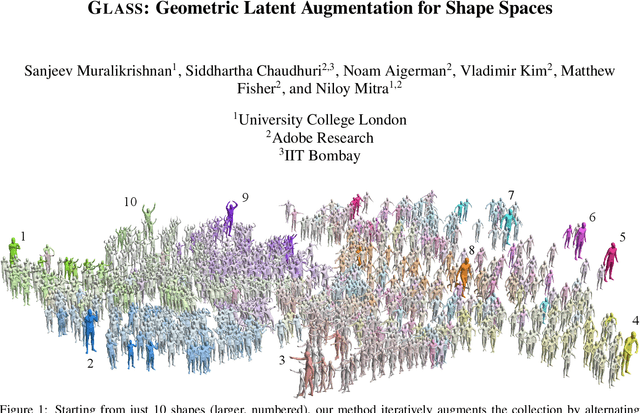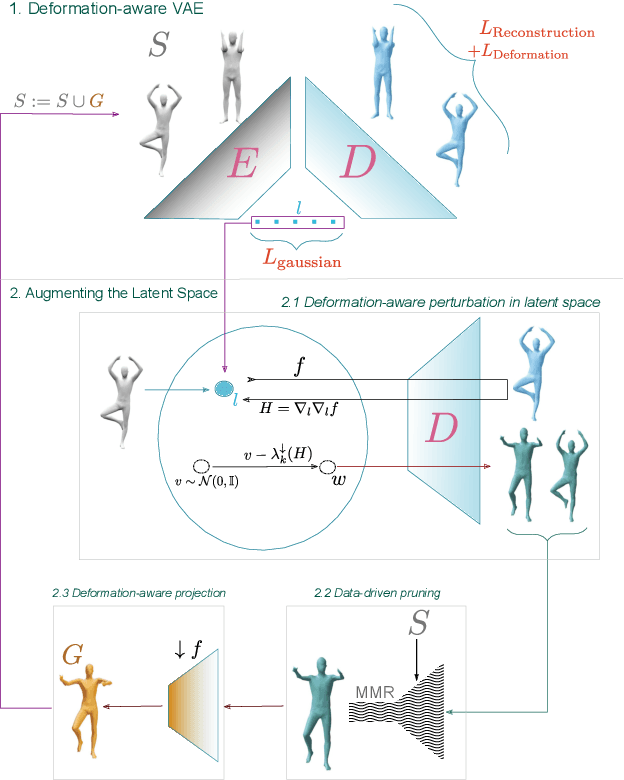Niloy Mitra
On Unifying Video Generation and Camera Pose Estimation
Jan 02, 2025



Abstract:Inspired by the emergent 3D capabilities in image generators, we explore whether video generators similarly exhibit 3D awareness. Using structure-from-motion (SfM) as a benchmark for 3D tasks, we investigate if intermediate features from OpenSora, a video generation model, can support camera pose estimation. We first examine native 3D awareness in video generation features by routing raw intermediate outputs to SfM-prediction modules like DUSt3R. Then, we explore the impact of fine-tuning on camera pose estimation to enhance 3D awareness. Results indicate that while video generator features have limited inherent 3D awareness, task-specific supervision significantly boosts their accuracy for camera pose estimation, resulting in competitive performance. The proposed unified model, named JOG3R, produces camera pose estimates with competitive quality without degrading video generation quality.
Track4Gen: Teaching Video Diffusion Models to Track Points Improves Video Generation
Dec 10, 2024Abstract:While recent foundational video generators produce visually rich output, they still struggle with appearance drift, where objects gradually degrade or change inconsistently across frames, breaking visual coherence. We hypothesize that this is because there is no explicit supervision in terms of spatial tracking at the feature level. We propose Track4Gen, a spatially aware video generator that combines video diffusion loss with point tracking across frames, providing enhanced spatial supervision on the diffusion features. Track4Gen merges the video generation and point tracking tasks into a single network by making minimal changes to existing video generation architectures. Using Stable Video Diffusion as a backbone, Track4Gen demonstrates that it is possible to unify video generation and point tracking, which are typically handled as separate tasks. Our extensive evaluations show that Track4Gen effectively reduces appearance drift, resulting in temporally stable and visually coherent video generation. Project page: hyeonho99.github.io/track4gen
Diffusion Handles: Enabling 3D Edits for Diffusion Models by Lifting Activations to 3D
Dec 06, 2023



Abstract:Diffusion Handles is a novel approach to enabling 3D object edits on diffusion images. We accomplish these edits using existing pre-trained diffusion models, and 2D image depth estimation, without any fine-tuning or 3D object retrieval. The edited results remain plausible, photo-real, and preserve object identity. Diffusion Handles address a critically missing facet of generative image based creative design, and significantly advance the state-of-the-art in generative image editing. Our key insight is to lift diffusion activations for an object to 3D using a proxy depth, 3D-transform the depth and associated activations, and project them back to image space. The diffusion process applied to the manipulated activations with identity control, produces plausible edited images showing complex 3D occlusion and lighting effects. We evaluate Diffusion Handles: quantitatively, on a large synthetic data benchmark; and qualitatively by a user study, showing our output to be more plausible, and better than prior art at both, 3D editing and identity control. Project Webpage: https://diffusionhandles.github.io/
CADTalk: An Algorithm and Benchmark for Semantic Commenting of CAD Programs
Nov 30, 2023



Abstract:CAD programs are a popular way to compactly encode shapes as a sequence of operations that are easy to parametrically modify. However, without sufficient semantic comments and structure, such programs can be challenging to understand, let alone modify. We introduce the problem of semantic commenting CAD programs, wherein the goal is to segment the input program into code blocks corresponding to semantically meaningful shape parts and assign a semantic label to each block. We solve the problem by combining program parsing with visual-semantic analysis afforded by recent advances in foundational language and vision models. Specifically, by executing the input programs, we create shapes, which we use to generate conditional photorealistic images to make use of semantic annotators for such images. We then distill the information across the images and link back to the original programs to semantically comment on them. Additionally, we collected and annotated a benchmark dataset, CADTalk, consisting of 5,280 machine-made programs and 45 human-made programs with ground truth semantic comments to foster future research. We extensively evaluated our approach, compared to a GPT-based baseline approach, and an open-set shape segmentation baseline, i.e., PartSLIP, and reported an 83.24% accuracy on the new CADTalk dataset. Project page: https://enigma-li.github.io/CADTalk/.
HOLODIFFUSION: Training a 3D Diffusion Model using 2D Images
Mar 29, 2023Abstract:Diffusion models have emerged as the best approach for generative modeling of 2D images. Part of their success is due to the possibility of training them on millions if not billions of images with a stable learning objective. However, extending these models to 3D remains difficult for two reasons. First, finding a large quantity of 3D training data is much more complex than for 2D images. Second, while it is conceptually trivial to extend the models to operate on 3D rather than 2D grids, the associated cubic growth in memory and compute complexity makes this infeasible. We address the first challenge by introducing a new diffusion setup that can be trained, end-to-end, with only posed 2D images for supervision; and the second challenge by proposing an image formation model that decouples model memory from spatial memory. We evaluate our method on real-world data, using the CO3D dataset which has not been used to train 3D generative models before. We show that our diffusion models are scalable, train robustly, and are competitive in terms of sample quality and fidelity to existing approaches for 3D generative modeling.
3inGAN: Learning a 3D Generative Model from Images of a Self-similar Scene
Nov 27, 2022Abstract:We introduce 3inGAN, an unconditional 3D generative model trained from 2D images of a single self-similar 3D scene. Such a model can be used to produce 3D "remixes" of a given scene, by mapping spatial latent codes into a 3D volumetric representation, which can subsequently be rendered from arbitrary views using physically based volume rendering. By construction, the generated scenes remain view-consistent across arbitrary camera configurations, without any flickering or spatio-temporal artifacts. During training, we employ a combination of 2D, obtained through differentiable volume tracing, and 3D Generative Adversarial Network (GAN) losses, across multiple scales, enforcing realism on both its 3D structure and the 2D renderings. We show results on semi-stochastic scenes of varying scale and complexity, obtained from real and synthetic sources. We demonstrate, for the first time, the feasibility of learning plausible view-consistent 3D scene variations from a single exemplar scene and provide qualitative and quantitative comparisons against recent related methods.
COFS: Controllable Furniture layout Synthesis
May 29, 2022



Abstract:Scalable generation of furniture layouts is essential for many applications in virtual reality, augmented reality, game development and synthetic data generation. Many existing methods tackle this problem as a sequence generation problem which imposes a specific ordering on the elements of the layout making such methods impractical for interactive editing or scene completion. Additionally, most methods focus on generating layouts unconditionally and offer minimal control over the generated layouts. We propose COFS, an architecture based on standard transformer architecture blocks from language modeling. The proposed model is invariant to object order by design, removing the unnatural requirement of specifying an object generation order. Furthermore, the model allows for user interaction at multiple levels enabling fine grained control over the generation process. Our model consistently outperforms other methods which we verify by performing quantitative evaluations. Our method is also faster to train and sample from, compared to existing methods.
Differentiable Surface Triangulation
Sep 22, 2021



Abstract:Triangle meshes remain the most popular data representation for surface geometry. This ubiquitous representation is essentially a hybrid one that decouples continuous vertex locations from the discrete topological triangulation. Unfortunately, the combinatorial nature of the triangulation prevents taking derivatives over the space of possible meshings of any given surface. As a result, to date, mesh processing and optimization techniques have been unable to truly take advantage of modular gradient descent components of modern optimization frameworks. In this work, we present a differentiable surface triangulation that enables optimization for any per-vertex or per-face differentiable objective function over the space of underlying surface triangulations. Our method builds on the result that any 2D triangulation can be achieved by a suitably perturbed weighted Delaunay triangulation. We translate this result into a computational algorithm by proposing a soft relaxation of the classical weighted Delaunay triangulation and optimizing over vertex weights and vertex locations. We extend the algorithm to 3D by decomposing shapes into developable sets and differentiably meshing each set with suitable boundary constraints. We demonstrate the efficacy of our method on various planar and surface meshes on a range of difficult-to-optimize objective functions. Our code can be found online: https://github.com/mrakotosaon/diff-surface-triangulation.
GLASS: Geometric Latent Augmentation for Shape Spaces
Aug 09, 2021



Abstract:We investigate the problem of training generative models on a very sparse collection of 3D models. We use geometrically motivated energies to augment and thus boost a sparse collection of example (training) models. We analyze the Hessian of the as-rigid-as-possible (ARAP) energy to sample from and project to the underlying (local) shape space, and use the augmented dataset to train a variational autoencoder (VAE). We iterate the process of building latent spaces of VAE and augmenting the associated dataset, to progressively reveal a richer and more expressive generative space for creating geometrically and semantically valid samples. Our framework allows us to train generative 3D models even with a small set of good quality 3D models, which are typically hard to curate. We extensively evaluate our method against a set of strong baselines, provide ablation studies and demonstrate application towards establishing shape correspondences. We present multiple examples of interesting and meaningful shape variations even when starting from as few as 3-10 training shapes.
SketchGen: Generating Constrained CAD Sketches
Jun 04, 2021



Abstract:Computer-aided design (CAD) is the most widely used modeling approach for technical design. The typical starting point in these designs is 2D sketches which can later be extruded and combined to obtain complex three-dimensional assemblies. Such sketches are typically composed of parametric primitives, such as points, lines, and circular arcs, augmented with geometric constraints linking the primitives, such as coincidence, parallelism, or orthogonality. Sketches can be represented as graphs, with the primitives as nodes and the constraints as edges. Training a model to automatically generate CAD sketches can enable several novel workflows, but is challenging due to the complexity of the graphs and the heterogeneity of the primitives and constraints. In particular, each type of primitive and constraint may require a record of different size and parameter types. We propose SketchGen as a generative model based on a transformer architecture to address the heterogeneity problem by carefully designing a sequential language for the primitives and constraints that allows distinguishing between different primitive or constraint types and their parameters, while encouraging our model to re-use information across related parameters, encoding shared structure. A particular highlight of our work is the ability to produce primitives linked via constraints that enables the final output to be further regularized via a constraint solver. We evaluate our model by demonstrating constraint prediction for given sets of primitives and full sketch generation from scratch, showing that our approach significantly out performs the state-of-the-art in CAD sketch generation.
 Add to Chrome
Add to Chrome Add to Firefox
Add to Firefox Add to Edge
Add to Edge